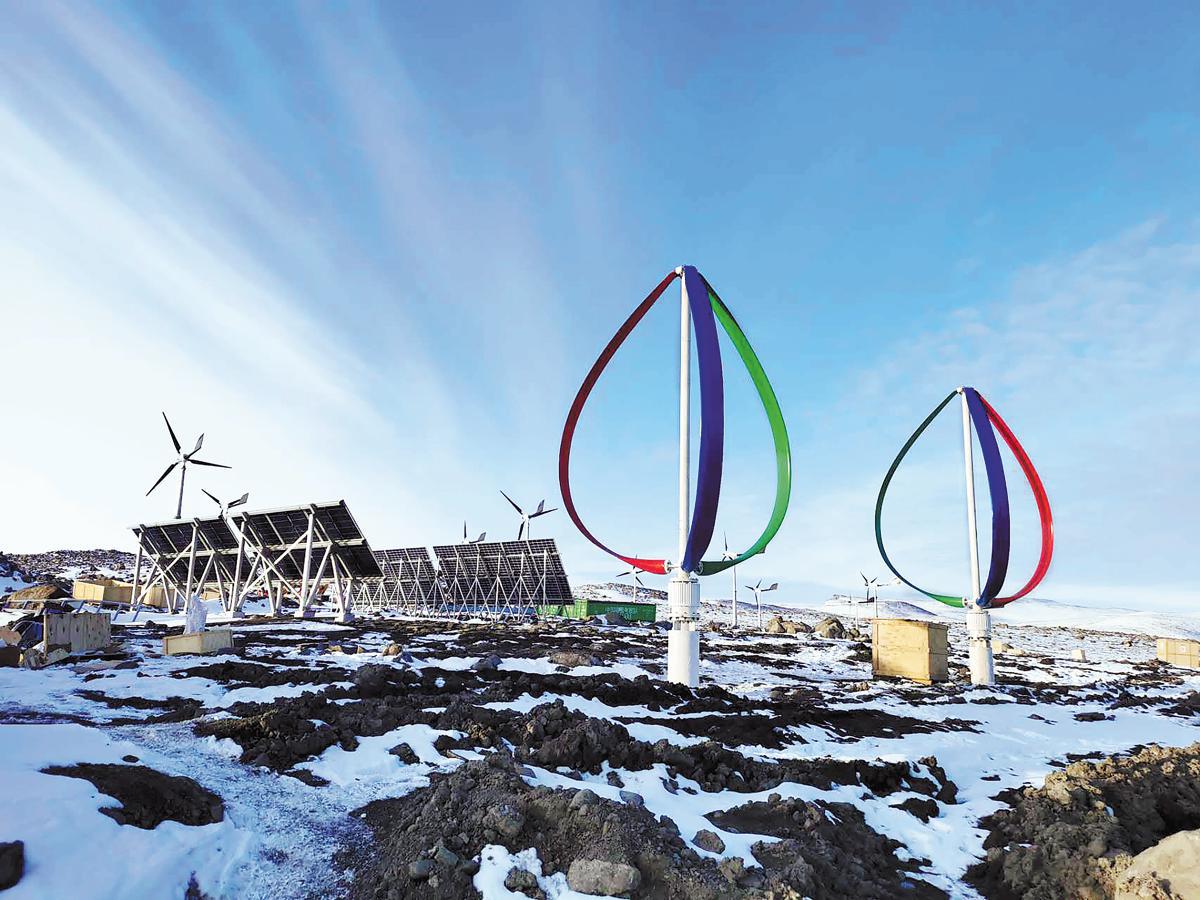
 0 Comment(s)
0 Comment(s) Print
Print E-mail China Daily, April 22, 2025
E-mail China Daily, April 22, 2025
Two droplet-shaped wind turbines spin in front of China's Qinling station in Antarctica. [Photo/China Daily]
A clean energy system tailored for polar conditions has been put into operation in China's Qinling station in Antarctica.
The breakthrough means China has become the first country to achieve the large-scale operation of a clean energy system under extreme Antarctic conditions.
Lead scientist Sun Hongbin, 56, told China Daily that the project marks an achievement in China's green scientific exploration in the field of polar energy, and signifies that the nation's polar exploration has developed from the diesel era into a new era of green energy.
The system will generate a wealth of data, as well as present challenges that will prompt continuous research, said Sun, who is also the chief scientist on polar clean energy at the Polar Research Institute of China and president of Taiyuan University of Technology in Shanxi province.
Since the launch of the system on March 1, it has replaced traditional diesel power sources, providing uninterrupted zero-carbon power for the research equipment and essential living facilities at Qinling station, which was established in February last year as China's fifth Antarctic research station.
Photovoltaic and wind power account for 60 percent of the energy capacity of the system. In situations without wind or sunlight, stored hydrogen can provide power to the station, ensuring short-term operation for research equipment and basic living facilities.
Sun stressed the primary challenges in ensuring the reliability and safety of the equipment. For instance, the development of the droplet-shaped wind turbine capable of operating on ice caps and hydrogen fuel cells demands cold-resistant power-up technology.
Construction of the system at the station commenced in 2023.
As much of the equipment and facilities required specialized research and modification to adapt to the extreme conditions, Taiyuan University of Technology established a digital twin laboratory simulating the environment of Antarctica.
This laboratory possesses the capabilities to simulate nearly 10 extreme conditions, including extreme cold, strong winds, blizzards, polar day and night, intense geomagnetic fields, strong ultraviolet radiation, low pressure and low oxygen levels.
The primary purpose of establishing this laboratory was to address the challenges of research, testing and operation, Sun said.
"Once the equipment arrives in Antarctica, we have no means to procure a replacement if a single screw malfunctions," he said. "Before deployment to Antarctica, various new energy devices underwent testing here. Now the laboratory receives and analyzes real-time data transmitted back from Antarctica."
In recent years, various countries have explored approaches to develop clean energy in Antarctica, with solar and wind energy being the primary focus.
However, the extreme conditions and shortage of technologies make it tough for solar and wind power generation equipment to maintain stable and efficient operation.
China is the first country to implement hydrogen energy in the extreme environment of Antarctica on a large scale, said Dou Yinke, dean of the Taiyuan university's College of Electrical and Power Engineering, and a leading expert who has participated in multiple Antarctic expeditions since 2004.
Against the backdrop of global warming and glacier melting, China proposed the concept of "green exploration" in 2017, Dou said. International organizations have repeatedly urged countries to transition from fuel-based power generation to clean energy in Antarctica.
As Antarctica possesses vast wind and solar energy potential, countries worldwide have been exploring clean energy in this area.
To date, approximately 30 Antarctic research stations have installed clean energy generation devices, with over half utilizing solar or wind, Dou said.
However, due to the lack of systematic application and development of clean energy technologies tailored to the Antarctic environment, these systems cannot yet fully replace traditional energy systems on the aspects of safety and stability, he said.
Currently, 80 to 90 percent of the world's Antarctic research stations still rely on fuel-powered electricity generation, leading to significant environmental pollution in the polar regions, said Dou.
Last year, the Taiyuan university led the formulation of the "Twelve-Year Development Outline for Clean Energy Utilization Technologies in the Antarctic", aiming to establish a comprehensive clean energy supply system for Antarctic research stations by 2035.
"I will dedicate my whole life to the cause. I believe we have just taken the first step on a long journey. It is a demonstration and an experiment," Sun said. Key technology breakthroughs can also drive the energy revolution in the province, a major energy base in China, said Sun.
Sun hopes to establish a 20,000-square-meter Antarctic extreme environment simulation laboratory in Shanxi to enhance future research.
"With clean energy, people can survive in polar regions. In the future, we may even install and test this technology on the moon and Mars," Sun said.
| 全职是什么意思hcv9jop0ns2r.cn | 猫头鹰属于什么科hcv9jop8ns2r.cn | 5月11日是什么星座hkuteam.com | oem贴牌是什么意思hcv8jop6ns9r.cn | 灌顶是什么意思hcv9jop2ns0r.cn |
| 江诗丹顿是什么档次hcv9jop5ns8r.cn | 孩子积食发烧吃什么药shenchushe.com | 甘油三酯偏高是什么原因hcv8jop0ns7r.cn | 吃什么水果祛斑最快hcv8jop3ns3r.cn | 什么水果补血hcv8jop6ns6r.cn |
| 牙齿有裂纹是什么原因hcv8jop8ns5r.cn | 送父亲什么礼物好hcv7jop9ns3r.cn | 截根疗法是什么hcv7jop9ns1r.cn | 梦见蛇预示着什么gangsutong.com | 什么食物含钾最高hcv7jop6ns8r.cn |
| 心跳过快是什么原因hcv8jop9ns0r.cn | 检查痛风挂什么科hcv8jop5ns6r.cn | 强字五行属什么hcv8jop6ns2r.cn | 手的皮肤黄是什么原因jingluanji.com | 什么一梦hcv9jop6ns7r.cn |
Go to Forum >>0 Comment(s)